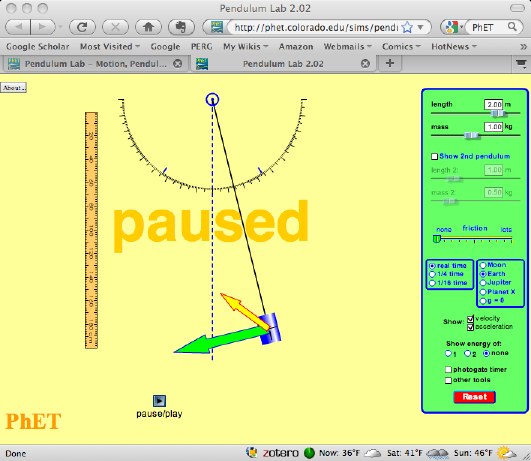
Teaching Physics with the Physics Suite
Edward F. Redish
Home | Action Research Kit| Sample Problems | Resources | Product Information
Problems Sorted by Type | Problems Sorted by Subject | Problems Sorted by Chapter in UP
 |
Teaching Physics with the Physics Suite Edward F. Redish Home | Action Research Kit| Sample Problems | Resources | Product Information |
Problems Sorted by Type | Problems Sorted by Subject | Problems Sorted by Chapter in UP |
For this problem, use the PhET simulation Pendulum Lab. This simulation mimics a real pendulum and allows you to adjust the initial position, the mass, and the length of the pendulum. Start the simulation. You can drag the pendulum to an arbitrary initial angle and release it from rest. You can adjust the length and the mass of the pendulum using the slider bars at the top of the green panel. Velocity and acceleration vectors can be selected to be shown, as well as the forms of energy. Feel free to play around with the simulation. When you are done, click the Reset button. A. Select to show the energy of pendulum 1. Be sure that friction is set to none. Drag the pendulum to an angle (with respect to the vertical) of 30o, and then release it. When the pendulum is at -30o, what form(s) of energy does it have? B. Drag the pendulum to an angle (with respect to the vertical) of 30o, and then release it. At what angle is the pendulum swinging the fastest? C. Drag the pendulum to an angle (with respect to the vertical) of 30o, and then release it. Select to show the acceleration vector. With the pendulum swinging back and forth, at which locations is the acceleration equal to zero? |
 |
D. With the pendulum swinging back and forth, how does the tension of the rope compare to the force of gravity when the angle is 0\degree?
E. Drag the pendulum to an angle (with respect to the vertical) of 90o, and then release it. With the pendulum swinging back and forth, where is the tension equal to zero?
F. The period of oscillation is the amount of time it takes for the pendulum to take a full swing, going from the original angle to the other side, and returning to the original angle. You can determine the period by selecting other tools, which gives you a stopwatch. With the pendulum swinging, you can start the stopwatch when the pendulum is at its original angle and time how long it takes to complete 10 swings. The period will be this time interval divided by 10 (this method is more accurate than trying to time one swing). Set the length of the pendulum to 1.0 m and the mass to 1.0 kg. Click Reset, and then drag the pendulum to an angle (with respect to the vertical) of 30o and release it. What is the period of oscillation?
G. How does the period of oscillation depend on the initial angle of the pendulum when released? (Be sure to measure the period for initial angles much greater than 30o.)
H. Keeping the length of the pendulum fixed, determine the period for a few different masses. (Alternatively, you can set up two pendulums by selecting Show 2nd pendulum. Adjust the lengths to be the same, and have one pendulum with a higher mass. You can release one and then release the other, with the same angle, when the first one is back at that angle.) How does the period of the pendulum depend on mass?
I. Now, keep the mass fixed to any value you choose and measure the period for several different pendulum lengths. How does the period of the pendulum depend on the length?
J. Now, change the planet where the experiment takes place to see how the period of oscillation depends on the acceleration due to gravity, g (on Earth, g ~10 m/s/s; g is larger than this value on Jupiter and smaller than this value on the Moon). How does the period of oscillation depend on the value of g?
(To be solved on MP)